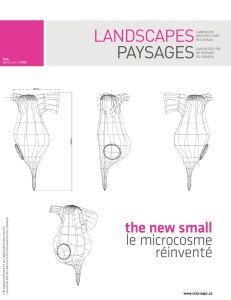 The World’s Societies have become largely urban; nearly everywhere, land has been occupied or colonized. Where once identity and community were linked to the land and to natural systems, the landscape is being stripped away, new layers added. During this process of transformation, society has become accustomed to an ‘urban approach’: a reliance on interventions that inject lost or absent greenery into our cities.
The World’s Societies have become largely urban; nearly everywhere, land has been occupied or colonized. Where once identity and community were linked to the land and to natural systems, the landscape is being stripped away, new layers added. During this process of transformation, society has become accustomed to an ‘urban approach’: a reliance on interventions that inject lost or absent greenery into our cities.
The article by myself and Alyssa Schwann on ‘a non-urban approach’ in the Spring 2015 issue of Landscapes|Paysages, The Canadian Society of Landscape Architects’ journal, asks wether there is an alternative ideal to the above observations. Can the concept of a ‘non-urban approach’ or a ‘de-urbanisation’ frame a renewed way of envisioning landscape and urban design? By re-engaging with place, can we potentially achieve a harmonious co-existence between urban and rural, the natural and cultural, and the past and future?
While pondering these questions, our article explores three project in Canada for which Atelier Anonymous prepared landscape visions. Firstly, the landscape for the competition design for a new Art Gallery of Greater Victoria, Vancouver Island, BC. The housing development project 62M in Winnipeg, Manitoba; and landscaping at a renovated warehouse in Railtown, Vancouver, BC.
The full article text on ‘a non-urban approach’ can be found HERE as a pdf (1.2 MB, pg. 45-49 of the Landscapes|Paysages, Spring Issue 2015).
The full version of the Landscapes|Paysages, Spring 2015 Issue, vol. 17, no. 1 can be found as a Pdf (36.7 MB) under this LINK. This Issue is a theme number on the subject of ‘The New Small’ (Le microcosme réinventé).
The Issue also includes another article on ‘Nesting Instincts‘, by myself and Alyssa Schwann about one of our Atelier Anonymous’ projects in partnership with Mike Seymour. For the article, see this LINK (1.5 MB).
Text by Jan Haenraets
Jan Haenraets is a Director of Atelier Anonymous Landscapes Inc., Vancouver, BC, Canada

